
Beetles are insects that form the order Coleoptera, in the superorder Holometabola. Their front pair of wings are hardened into wing-cases, elytra, distinguishing them from most other insects. The Coleoptera, with about 400,000 described species, is the largest of all orders, constituting almost 40% of described insects and 25% of all known animal species; new species are discovered frequently, with estimates suggesting that there are between 0.9 and 2.1 million total species. Found in almost every habitat except the sea and the polar regions, they interact with their ecosystems in several ways: beetles often feed on plants and fungi, break down animal and plant debris, and eat other invertebrates. Some species are serious agricultural pests, such as the Colorado potato beetle, while others such as Coccinellidae eat aphids, scale insects, thrips, and other plant-sucking insects that damage crops. Some others also have unique characteristics, such as the common eastern firefly, which uses a light-emitting organ for mating and communication purposes

The sap beetles, also known as Nitidulidae, are a family of beetles.
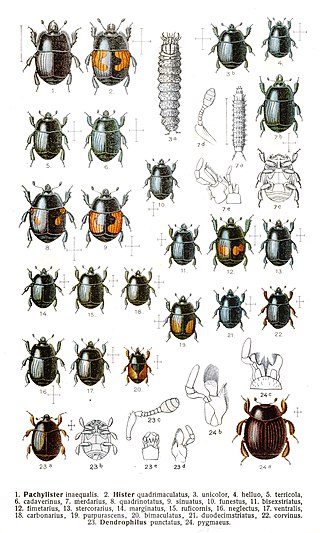
Histeridae is a family of beetles commonly known as clown beetles or hister beetles. This very diverse group of beetles contains 3,900 species found worldwide. They can be easily identified by their shortened elytra that leaves two of the seven tergites exposed, and their geniculate (elbowed) antennae with clubbed ends. These predatory feeders are most active at night and will fake death if they feel threatened. This family of beetles will occupy almost any kind of niche throughout the world. Hister beetles have proved useful during forensic investigations to help in time of death estimation. Also, certain species are used in the control of livestock pests that infest dung and to control houseflies. Because they are predacious and will even eat other hister beetles, they must be isolated when collected.
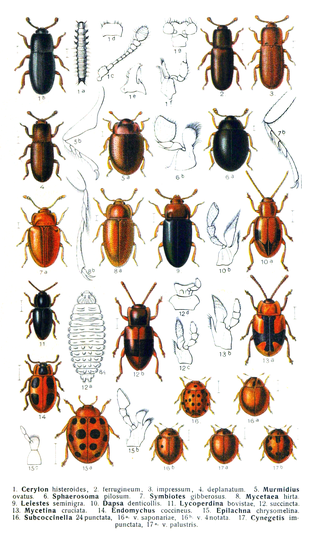
Cucujoidea is a superfamily of beetles. This group formerly included all of the families now included in the superfamily Coccinelloidea. They include some fungus beetles and a diversity of lineages of "bark beetles" unrelated to the "true" bark beetles (Scolytinae), which are weevils.

Dynastes tityus, the eastern Hercules beetle, is a species of rhinoceros beetle native to the Eastern United States. The adult's elytra are green, gray or tan, with black markings, and the whole animal, including the male's horns, may reach 60 mm (2.4 in) in length. The larvae feed on decaying wood from various trees.
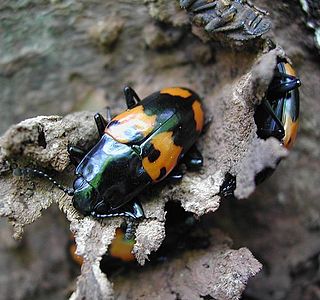
Megalodacne is a genus of fungivorous beetles in the family Erotylidae.

Glischrochilus[note 1] is a genus of sap-feeding and predatory beetles under the family Nitidulidae, subfamily Cryptarchinae. Most members of this genus are commonly known as picnic beetles or beer bugs.

The western Hercules beetle is a species of rhinoceros beetle that lives in Arizona, New Mexico and Utah in the United States and in parts of northern Mexico. This species is known for its grayish-white elytra, large size, and characteristic horn of the adult males.
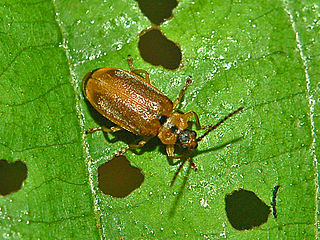
Galerucella is a genus of leaf beetles in the family Chrysomelidae described by George Robert Crotch in 1873. It is widely distributed but absent in the Neotropics. Some species feed on waterlilies and are used as biocontrol of introduced, invasive waterlilies. Galerucella tenella feed on strawberry plants.
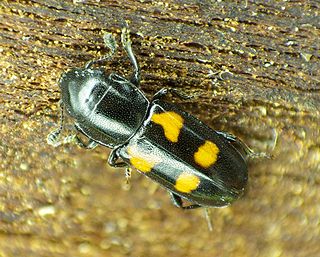
Glischrochilus quadripunctatus, commonly known as the European bark beetle predator is a species of beetle in the genus Glischrochilus of the family Nitidulidae.

Carpophilus lugubris, commonly known as the dusky sap beetle, is a species of beetle in the genus Carpophilus. It is an agricultural pest of corn and tomato.

Epuraea is a genus of sap-feeding beetles in the family Nitidulidae, first described in 1843 by Wilhelm Ferdinand Erichson. There are at least 40 described species in Epuraea. Their most notable food source is sap but these beetles also feed on organic matter such as fruits, flowers, fungi, decaying plant tissue, and the tissue of dead animals. Some species occur in bumblebee nests. Epuraea beetles commonly overwinter underneath logs or in soil.

Glischrochilus quadrisignatus, known generally as four-spotted sap beetle, is a species of sap-feeding beetle in the family Nitidulidae. Other common names include the beer bug and picnic beetle. It is found in North America.
Glischrochilus obtusus is a species of sap-feeding beetle in the family Nitidulidae. It is found in North America.
Glischrochilus sanguinolentus is a species of sap-feeding beetle in the family Nitidulidae. It is found in North America.
Glischrochilus vittatus is a species of sap-feeding beetle in the family Nitidulidae. It is found in North America.
Glischrochilus confluentus is a species of sap-feeding beetle in the family Nitidulidae. It is found in North America.
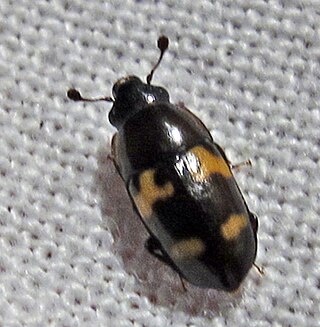
Glischrochilus fasciatus, the picnic beetle, is a species of sap-feeding beetle in the family Nitidulidae. It is found in Central America and North America.
Glischrochilus siepmanni is a species of sap-feeding beetle in the family Nitidulidae. It is found in North America.














